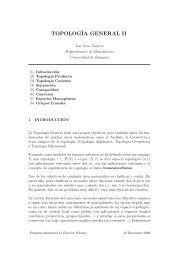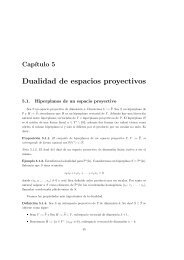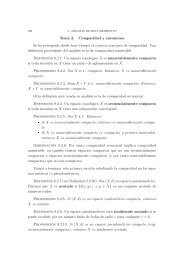Logística: Matemáticas y Ejército I. - Universidad de Zaragoza
Logística: Matemáticas y Ejército I. - Universidad de Zaragoza
Logística: Matemáticas y Ejército I. - Universidad de Zaragoza
Create successful ePaper yourself
Turn your PDF publications into a flip-book with our unique Google optimized e-Paper software.
The Cableways<br />
In the mountain every soldier on<br />
the frontline required a daily supply of<br />
materials, provisions and ammunition<br />
equal to his own weight, in addition<br />
were essential support services supplied<br />
by a further seven soldiers. A <strong>de</strong>nse<br />
network of roads were build to arrive<br />
at the foot of the mountain from where<br />
cableways carried the material up as<br />
high as possible. Squads of porters<br />
shuttled between the arrival station<br />
of the cableway and the huts and<br />
emplacements of the front line. On<br />
Lagazuoi at least four Italian cableways<br />
were constructed on the eastern slopes<br />
(one directly to the Martini Ledge and<br />
three to supply the Pre-Summit) and<br />
two Austrian cableways, one on the<br />
western si<strong>de</strong> leaving the Fort Tre Sassi<br />
and a further which climbed up from<br />
Sare (near the Capanna Alpini inn) to<br />
the Scotoni inn and from here reached<br />
the saddle of Lagazuoi. The construction<br />
of the cableways was one of the many<br />
technical problems that had to be solved<br />
in mountain warfare, complicated by<br />
the continual <strong>de</strong>structive activity of<br />
enemy artillery fire. Above all the Italian<br />
cableways were subjected to Austro-<br />
Hungarian artillery fire from the Sasso<br />
di Stria and so were operated un<strong>de</strong>r the<br />
cover of night fall to reduce losses of<br />
men and materials.<br />
The Martini Ledge<br />
The Martini Ledge was the most<br />
important emplacement in this sector<br />
of the front. During the course of the<br />
war accommodations, field kitchens,<br />
and warehouses, a cableway station, a<br />
forge, a telephone exchange, carpentry<br />
shop, or<strong>de</strong>rly room and medical posts<br />
were all constructed. The original access<br />
path, exposed to bombardments from<br />
the Sasso di Stria was subsequently<br />
replaced by a long tunnel leading<br />
behind the lines, safe from enemy fire.<br />
The <strong>de</strong>fence of the ledge by the Italians<br />
and the attempts the Austro Hungarian<br />
forces to <strong>de</strong>stroy it were the origin of<br />
all the military activity on the Lagazuoi<br />
front. The emplacements on the ledge<br />
were capable of firing at the Austro-<br />
Hungarian trenches in the Valparola<br />
Pass, causing significant losses and<br />
providing a precise gui<strong>de</strong> for the Italian<br />
artillery fire from the Averau and<br />
the Cinque Torri onto those lines.<br />
To neutralise this threat the Austro –<br />
Hungarian committed all their available<br />
resources. Initially attempting an attack<br />
from their positions above the ledge<br />
on the crest of Lagazuoi and the Pre-<br />
Summit (at 2668). Subsequently they<br />
dug three tunnels to mine the ledge but<br />
all attempts failed. A further notably<br />
long tunnel was planned to reach the<br />
ledge from below commencing at<br />
the foot of Lagazuoi but it was never<br />
finished.<br />
Winter on Lagazuoi<br />
The war of positions drove the two<br />
armies to construct an uninterrupted<br />
line of barbed wire fencing and<br />
emplacements in the Valleys and on<br />
the mountains. This front was presi<strong>de</strong>d<br />
over by look-outs day and night, in all<br />
seasons even in the har<strong>de</strong>st winters.<br />
The winter of 1916 had the heaviest<br />
snowfall of the century with more than 8<br />
metres of snow covering the mountain,<br />
all access paths were covered along<br />
with the huts and emplacements. The<br />
real threat to the soldiers lives came<br />
from the avalanches the winter high up<br />
on the mountain was always a terrible<br />
enemy for both armies. The cold at these<br />
heights is truly biting. Temperatures can<br />
drop to - 30°, with blizzards making it<br />
impossible to remain outsi<strong>de</strong> exposed.<br />
Watch duties, which continued due to<br />
the fear of a sud<strong>de</strong>n enemy attack, were<br />
a real torture to the look out soldiers,<br />
who stood motionless so as not to be<br />
ARMAS Y CUERPOS 27<br />
<strong>de</strong>tected by enemy snipers positioned<br />
only tens of metres away.<br />
Warfare on the rockface<br />
Fighting on the rockface called for<br />
good technical competence, organisation<br />
ability, agility and nerves of steel. It was<br />
a war fought between machine guns,<br />
positioned in embrasures secretly<br />
carved out of the rock, and ready to fire<br />
as soon the enemy ma<strong>de</strong> the slightest<br />
movement. A war of daring squads<br />
who climbed or were lowered down<br />
towards the enemy positions to study<br />
their weak points, evaluate <strong>de</strong>fences,<br />
<strong>de</strong>termine artillery positions and troop<br />
movements, in the dark and absolute<br />
silence along long stretches exposed<br />
to enemy fire and onto which machine<br />
guns were previously aimed at and





